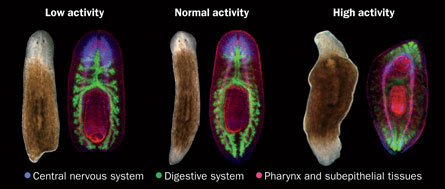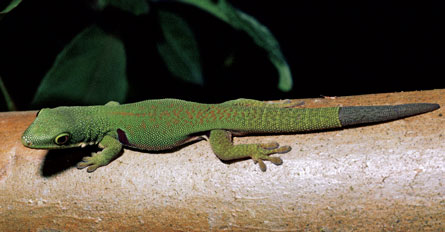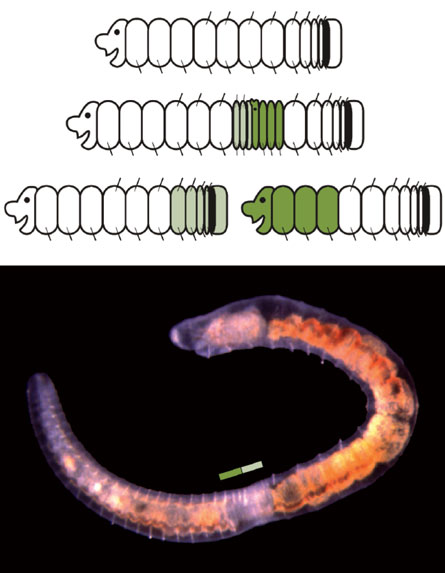Starting Anew
Scientists turn to lowly creatures to unlock the secrets of regeneration
It could have been a scene from a sequel to Jurassic Park: Peering down at the tiny worms wriggling under the lens of her microscope, biologist Alexandra Bely witnessed a performance that hadn’t been played in nature in millions of years. The beastie was sprouting a second head.



Actually, two-headed worms are common in Bely’s lab at the University of Maryland in College Park. But this specimen belongs to a species that had long ago lost the unusual regenerative ability.
That species, Paranais litoralis, is part of an ancient family of worms called naidids that settle in the soft sediments alongside streams and ponds. Generally, if a sudden rush of water or a hungry predator causes a naidid to lose its head, it will simply grow another one. But some species that Bely and colleagues have studied, including Pa. litoralis, seem to have lost this power. So it surprised Bely to see that, with the right timing, the creature could regain its head-popping potential.
“That’s very exciting, because it indicates that the ability to regenerate is still there, in a dormant state,” Bely says, “though it probably hasn’t been expressed or seen in millions of years.”
Bely’s finding and other recent results have encouraged researchers who are trying to figure out why some animals can reconstruct their body parts while others can’t. Most species have the ability to regenerate some body parts, yet this talent is highly variable. Humans, for instance, can renew skin and bone, but salamanders can re-create entire limbs or tails, or just about any other structure that can be lopped off without killing them. And the real superstars are animals such as sea stars, flatworms and sponges: They can regenerate every part of their body, even from a tiny fragment.
Given the obvious medical appeal of regrowing lost or injured body tissues, scientists have long focused on the molecular signals that drive regeneration — endowing some animals with extensive powers while countless others have limited or no regenerative abilities at all. In recent years, scientists have begun to explore the regenerative process in diverse creatures to better understand how that power evolved in the first place and why not everything has it.
The findings have raised a nagging question: Are the regenerative powers that lead to a new head in a worm, restore the leg of a salamander and heal the skin of a human one and the same? Some scientists maintain that regeneration is ancient and originated long ago, while others say it has evolved, again and again, in different organisms.
Bely says figuring out whether regenerative abilities in all animals had the same evolutionary origins is the “elephant in the room” for regeneration biology. “Whether or not regenerative processes are homologous across the animal kingdom profoundly affects how we interpret what we learn about regeneration in different animal groups.”
In the past, researchers have sought a single explanation for the wide variation in regenerative abilities. Since animals across the board have some renewing potential, some scientists have suggested that complex creatures tended to lose the regenerative ability as evolution proceeded, while simpler animals retained it. Recent studies on the genes and signaling pathways involved in regeneration show that its presence or absence is driven by multiple factors, as Bely and colleague Kevin Nyberg describe in a paper to appear in Trends in Ecology & Evolution.
To determine whether all regeneration has the same roots, scientists must identify its molecular basis in different groups of organisms. Bely and other researchers discussed the evolutionary aspects of regeneration — as well as ecological and physiological factors that play into it — in January in Seattle at the Society for Integrative and Comparative Biology meeting.
“If you look at the Metazoan tree of life and look at all the phyla that have been described so far, you will find organisms that can do some remarkable regenerative feats,” says Alejandro Sánchez Alvarado, a neurobiologist at the University of Utah in Salt Lake City who spoke at a panel session at the meeting. “That to me supports the possibility that regeneration is not something that every animal invents for their own purposes, but that it may actually be an attribute of our predecessors, our ancestors a long, long time ago in evolution.”
Early arms race
Signs of animals’ regenerative abilities are scattered throughout the fossil record. Geologist Forest Gahn of Brigham Young University–Idaho in Rexburg studies crinoids — marine animals related to modern sea stars and sea urchins — and says the first fossils of these animals, dating back 490 million years, reveal evidence of limb regrowth.
Crinoids are flower-shaped animals that grow on stalks rooted to the ocean floor. Like their sea star cousins, crinoids have five or more arms and a skeleton constructed of calcified plates elaborately slotted together. Some of the plate connections are designed for shedding, so an animal grabbed by a predator can simply bid an arm good-bye.
In looking over the fossil record, Gahn and colleague Tomasz Baumiller of the University of Michigan in Ann Arbor linked shedding and regrowth to increased evolutionary pressure to withstand predator attacks. Because modern-day crinoids usually lose and regenerate their arms as a result of attacks by fish and other marine animals, the scientists reasoned that arm regeneration in fossil crinoids might be an indicator of past predator-prey interactions.
Gahn and Baumiller examined more than 2,500 crinoid fossils for evidence of arm regeneration, focusing on specimens dating back 290 million to 490 million years. The scientists reported in 2004 that a threefold increase in the relative number of fossils showing arm regeneration occurred about 380 million years ago, a time when the number of shell-crushing predators increased explosively.
Not all of the crinoid species from that period showed a dramatic increase in regeneration. Those species that did were the tallest, and among the tallest, the bigger-than-average individuals showed the highest regeneration frequencies. Gahn says these findings are consistent with something called the “plant apparency theory,” which states that the most readily seen plants are those that are most likely to be attacked by predators. Those plant species are also the most likely to develop broader defenses against predators.
Apparency theory seems to hold true for this fossil community, Gahn says. The prevalence of shell-crushers coincides with the appearance of other defenses, too, such as thicker plates and changes in arm branching to minimize arm loss.
Still, finding evidence of changes in both predators and prey does not prove that one caused the other, Gahn notes. The scientists are now doing experiments to see if regeneration is selectively advantageous in living crinoids. In January, he and Baumiller traveled to Micronesia to study predator-prey interactions in reef crinoids to better assess how the type and frequency of tissue loss might help mold predator-driven regeneration.
Making headway
Regeneration is a form of reproduction for some invertebrates. Sea stars, brittle stars and hydra, for example, reproduce asexually by essentially splitting in two. Some worms, such as the naidids, use a variation on their regenerative technique to make a second version of themselves as well.
Naidids are part of the annelid family that includes ordinary roundworms, leeches and earthworms. Most naidids reproduce by budding, a process in which a new individual starts as a growth on the parent’s body and eventually splits off. But some naidid species employ a more elaborate process called fission. To reproduce, a worm in one of these species forms a zone of self-proliferation in the middle of its body. From that zone, the worm forms a new head to go with its back end and a new tail to go with its front. Attached head-to-tail–head-to-tail, the worm eventually tears itself in two.
Among the fission reproducers, Bely discovered a few oddballs: These worms, of which Pa. litoralis is one, reproduce and replace lost tails but cannot restore a lost or damaged head. But under certain circumstances, Bely and colleagues report online December 4 in the Proceedings of the National Academy of Sciences, head-regenerating abilities can be recovered in the species.
The researchers discovered that if the sprouting head was lost at an early stage during the fission reproduction process, there’s a way the animal could grow a new one. In a series of experiments, the scientists showed that if they chopped the tissue of a new head off as it was growing — before the animal split in two — the worm’s ability to regenerate the head could be recovered.
“It’s probably not ever being expressed in nature,” Bely says, “and yet we, by very specific cuts, can elicit regeneration.”
This pattern — where younger tissue is able to support regeneration much more effectively than older tissue — is also seen in humans. Young children, for example, have reportedly been able to regenerate severed fingertips. And pediatric surgeons can attest to the magical powers of regeneration that occur after fetal surgery in early pregnancy, where the baby is later born perfectly healed without scars.
Bely says such feats suggest that humans have the appropriate machinery to heal wounds without scars, perhaps even to regrow tissues or limbs. But in humans, this ability lies dormant, inactivated because evolution favored the swift patching of wounds through scarring over the slow regeneration of complete body parts.
Bely and her group are now studying Pa. litoralis to see how these dormant abilities are activated. Such studies may point researchers toward previously unstudied genes or processes that, if found in humans, could be modified to increase regeneration abilities, she says.
Common machinery
As the superstars of regeneration, flatworms known as planarians may also hold a treasure trove of clues. Cut off a planarian’s head and the worm regrows a head. Cut off the tail and it regrows a tail. Chop a planarian into 279 bits, and it will grow 279 entire new worms.
Over the past decade or so, University of Utah’s Sánchez Alvarado and his colleagues have cloned and tested thousands of planarian genes to see what roles they play in regeneration. The findings show that the vast majority of genes used to regenerate are shared by many forms of life, including plants, nematodes and humans. In addition, the genes are preserved, remaining essentially unchanged over eons.
“Many people have postulated that maybe the difference is that there are some genes that got ‘lost.’ And that by losing these genes, animals were incapable of mounting a regenerative response after injury or amputation,” Sánchez Alvarado says. “But we’re finding out that that’s just likely not to be true.” Instead, he says, the genes may be there but deployed in slightly different ways.
His group uses a process called RNA interference to turn off genes one by one. Through this process, the team showed how a signaling pathway — a series of molecular events within a cell — that orchestrates embryonic development also plays a role in regeneration. In this case, the pathway tells the worm whether to make a head or tail, based on the wound’s location.
When Sánchez Alvarado turned up the activity in the signaling pathway — called Wnt — the worms created tails in place of heads. When turned down, the worms created heads instead of tails.
In December, his group published further findings in Science that show how another ancient — an evolutionarily preserved — molecular signaling pathway, called hedgehog, serves as a master switch to regulate the Wnt pathway during regeneration. Sánchez Alvarado says these old signaling pathways are used to lay down the body plan of an embryo as it develops. However, his findings came as a surprise because the two pathways operate differently early in development.
In embryogenesis, the Wnt and hedgehog pathways work as a team, establishing a mutually dependent feedback loop that determines the embryo’s body plan. Sánchez Alvarado says the new findings establish a hierarchy of signaling events leading to one aspect of regeneration — in this case, deciding whether to make an anterior or posterior end.
“That already smells of some unique regulation in these two pathways to allow for regeneration to take place,” he says.
It remains to be seen whether these pathways are used in regeneration by other species such as zebra fish or salamanders, Sánchez Alvarado says. He and his team are now working to identify other signaling processes used in embryogenesis, and possibly regeneration.
“The question is, do you reuse these tools, which is very likely,” he says. “And if you reuse them for regeneration, how do you do it?”
Though regeneration and embryogenesis rely on many of the same molecular pathways, the processes are not the same at all, he says. In regenerating a limb, for example, the body must go back “in time” to re-create an organ in the absence of all the other events that took place at the time of early development. He says the local cues that tell damaged tissue how to behave appropriately and how to integrate into the surrounding tissue need to be identified.
Playing to a different tune
Though most of the molecular machinery that’s used in regeneration has been shown to be common to all multicelled animals, some machinery differs. So some scientists maintain that regeneration is not an ancient process that originated long ago, but exists because it has evolved, again and again, in different organisms.
Jeremy Brockes of University College London says that, like an orchestra playing different tunes, the key instruments are the same but they are being directed in different ways. His decade-long studies of salamanders have convinced him that extraordinary regenerative abilities have evolved independently in different animal groups.
He became convinced of this through his studies of the salamander protein Prod 1, which serves as a road map for cell regrowth in salamanders and newts (SN: 11/3/07, p. 276).
While most of the proteins and genes involved in regeneration that show up in other animals also have mammalian counterparts, Prod 1 is a protein found only in salamanders. What’s more, it’s a kind of protein — called a three-finger protein — that is involved in other “striking examples of local evolution,” Brockes says. For example, in snakes, a different three-finger protein played a role in the evolution of the venom apparatus.
Though such evolutionary events are relatively common, Brockes says it’s not the way most researchers think about regeneration.
“We have thought about regeneration as being a kind of unitary mechanism, and the question often is, ‘Why have we lost the ability to regenerate?’” he says. “But that doesn’t take into account these types of local evolutionary events.… After all, you only need one conductor to do something quite different with an orchestra.”
Brockes says it’s important how such issues are viewed, particularly in areas such as regenerative medicine.
“What we should be asking is, did we actually ‘lose’ the ability, or did the salamander bring significant evolutionary novelty to the problem of developing a regenerative response?” Brockes says.
He and his colleagues are now looking for other proteins used in regeneration and working to understand how proteins such as Prod 1 work to orchestrate a regenerative response.
What is needed next are studies to test how universal the mechanisms used by various regenerators are. Only then will scientists know whether humans and other nonregenerators have lost a trick learned and mastered by watery ancestors countless millions of years ago.
“It’s a long process, but it’s one that I think is really beginning to be chipped away effectively,” Sánchez Alvarado says. “It really will be just a matter of time.”
Susan Gaidos is a freelance writer based in Maine.